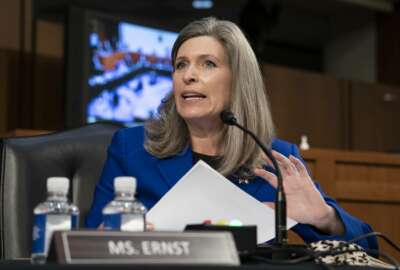USPS touts ‘net positive’ for customers in next phase of network modernization, but longer waits for some
USPS says its network modernization plans are badly needed to revitalize its legacy infrastructure, which was built to primarily transport letters,
The Postal Service is planning to roll out several changes next year to drive down its operating costs and ensure more reliable service to most of its customers.
USPS says the next step of its network modernization plan, which will happen next year, is to get mail and packages to their destination in fewer trips between mail processing plants and post offices.
The agency expects these adjustments will not only help it squeeze $3 billion of annual overhead costs out of its operations, but enable faster delivery of mail and packages to customers within 50 miles of the agency’s largest regional mail processing plants.
For customers outside that 50-mile radius, however, USPS, anticipates ”some mail and packages will experience a longer service standard,” according to a filing submitted to its regulator on Thursday.
In those cases, mail and packages in those more rural areas will remain in transit for about a day longer before reaching their final destination.
USPS, however, told the Postal Regulatory Commission that these changes will have a “net positive impact” on service for first-class mail, packages and marketing mail, and will be delivered “at the same level of service or faster,” for most customers.
“The Postal Service has significant discretion to determine how to fulfill our statutory obligations, including the discretion to determine how to best balance considerations of service adequacy with the need for economical and cost-effective operations,” USPS told its regulator.
USPS says 75% of first-class mail won’t see any change, and that it will deliver about two-thirds of mail in three days or less.
In all cases, for first-class mail and packages shipped via USPS Ground Advantage, delivery within five days is considered on-time.
USPS says it will continue to deliver prescription medicines through the mail “at their current speeds or faster,” under these plans, and that its service standards will still apply equally to rural and urban areas.
USPS expects these changes, once fully implemented, will cut $30 billion in costs over the next decade, and help put the agency back on track to achieve long-term financial stability.
“The proposed operational changes will modernize our ground transportation network to reflect changing customer needs, reduce costs to become financially self-sufficient, and provide more predictable and reliable service,” USPS wrote in a press release Thursday.
Postmaster General Louis DeJoy said in a statement that these changes, once implemented, will “improve service reliability, reduce cost and grow our business.”
‘You don’t want empty trucks all over the place’
For the next step in its network modernization plan, USPS is looking to cut costs by standardizing its transportation schedule for trucks carrying mail and packages from regional mail processing plants to community post offices, and vice versa.
Under this plan, trucks will drop off and pick up mail primarily in the morning for post offices that are the furthest from regional plants — drawing down end-of-day trips between these facilities.
“This consolidation will provide flexibility in our transportation scheduling, bring a significant amount of mail volume into USPS plants sooner to begin processing earlier, and reduce local transportation costs, carbon emissions, and truck trips through American neighborhoods,” the agency wrote.
DeJoy has repeatedly put his strategy in contrast to previous USPS plans before his tenure, which focused on closing and consolidating facilities, as well as limiting the hours at post offices.
DeJoy, in an exclusive interview earlier this year, said USPS has “begun to bear down on wasteful practices” that have led to higher costs and slower delivery.
“You don’t want empty trucks all over the place. You don’t fly stuff that you can get there by ground,” DeJoy told Federal News Network in February.
“This is by no means a consolidation of good stuff. This is a rearrangement of the furniture,” he added. “I imagine we’ll come out with more square footage deployed around the nation than before we started. It’s just not going to be wasteful square footage,” DeJoy said. “I’m talking about waste, and handling things 17 times, instead of handling it once or twice — because it’s doable. That’s what the other guys do.”
By making these changes, USPS expects it can provide faster service for local deliveries. In some areas, USPS expects all local mail will get delivered within three days “at the slowest,” and in some cases, it’ll achieve a two-day standard.
“This supports local commerce growth, enabling local communities to benefit from clearer service expectations,” USPS wrote.
Once these changes are fully implemented, USPS says customers will be able to look up any two five-digit ZIP codes and get a better understanding of how long it will take for their letter or package to arrive.
“Our updated service standards allow a customer to look up how long it will take a piece of mail to get from a specific ZIP code in Kansas City, MO to its final destination in Akron, OH,“ USPS wrote.
USPS also expects changes to its transportation network to allow mail and packages to travel further through its delivery network in a single day.
For example, a piece of first-class mail traveling 22 hours through the USPS network currently has a four-day service standard. But USPS expects these changes will get that same piece of mail delivered within three days.
Demands for better service, not just lower costs
USPS is presenting these upcoming changes as a net positive for both the agency’s bottom line and its customers.
USPS put some of its network modernization changes on hold until at least January 2025, at the request of a bipartisan group of House and Senate lawmakers.
More than a quarter of the Senate called for USPS to pause and reassess its plans, after on-time service deteriorated in areas — such as Atlanta, Houston and Richmond, Virginia — where USPS started opening Regional Processing & Distribution Centers (RPDCs).
These new, large facilities serve as hubs for long-distance transportation, where employees sort mail and packages going to other regions, as well as sort incoming packages for delivery in the region.
Thomas Day, vice chairman of the Postal Regulatory Commission, and a former USPS executive with more than 35 years of experience at the agency, said in a recent interview that USPS can — and should — improve service while also cutting costs.
“When you do the right steps to achieve consistent, reliable service performance, what you’re going to do is follow a process in an orderly manner, which also is cost-efficient. So, when you provide top quality service, you’re also going to provide the lowest possible cost, because the efficiencies come together,” Day said in an Aug. 7 interview. “There’s this mistaken belief that if we let mail go slower, we save money. No, you don’t. That is absolutely false.”
Members of the USPS Board of Governors, at a recent meeting, also stressed the need to provide reliable on-time delivery while trying to put the agency on firmer financial footing.
USPS Governor Dan Tangherlini, a former administrator of the General Services Administration, said the board remains committed to the goals of DeJoy’s 10-year reform plan, but said he’s “concerned about implementation performance and our ability to maintain customer support for these hard and necessary changes.”
USPS delivered more than 86% of first-class mail on time in the third quarter of this fiscal year — compared to about 92.5% for the same period last year.
USPS Governor Ron Stroman, a former deputy postmaster general, said that despite continued declines in first-class mail volume, “maintaining great customer service is essential to keeping your customer base.”
USPS changes coming in 2025
USPS says its network modernization plans are badly needed to revitalize legacy infrastructure, which was built to primarily transport letters and has been largely unchanged for decades.
First-class letters remain the agency’s most profitable product, but the agency is looking for other streams of revenue it can rely on to pay its bills — such as capturing a bigger share of a booming e-commerce package business from private-sector shippers, such as UPS, FedEx and Amazon.
USPS says that since 1997, first-class mail volume has fallen by 80%, “requiring us to shift from a network centered around individual pieces of mail to a network that is built around both letters and parcels.”
“These changes are designed to save costs, maintain or improve service levels for most mail and packages, and allow for volume advancement whenever possible. They ensure connectivity and the efficient delivery of essential items like medicines and ballots.
USPS won’t implement these changes until 2025, to avoid disruptions during November’s election or its busy holiday peak season.
“We remain committed to maintaining operational excellence as we implement these initiatives. To avoid disruptions during election and holiday seasons, further operational changes related to these refinements will not be implemented until 2025,” the agency wrote.
USPS will hold a virtual, public hearing on Sept. 5 to discuss these changes and gather feedback from its customers. After the hearing, it will seek an advisory opinion from its regulator, the Postal Regulatory Commission.
“Through this virtual conference, the Postal Service is soliciting feedback from our stakeholders, including the mailing and shipping community, to ensure the utmost transparency throughout the process and comply with the applicable Regulatory processes,” DeJoy said. “We also intend to solicit feedback from the Postal Regulatory Commission through the advisory opinion process.”
USPS, in some cases, has resisted efforts for the commission to take a closer look at its network modernization plans and other elements of its 10-year Delivering for America reform plan.
“After receiving an advisory opinion from the PRC, the Postal Service will consider the Commission’s opinion and finalize its decision,” USPS wrote.
Regardless of what the commission says about these proposed changes, the regulator’s advisory opinions are nonbinding.
Copyright © 2024 Federal News Network. All rights reserved. This website is not intended for users located within the European Economic Area.
Jory Heckman is a reporter at Federal News Network covering U.S. Postal Service, IRS, big data and technology issues.
Follow @jheckmanWFED






